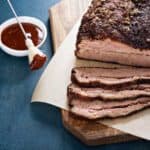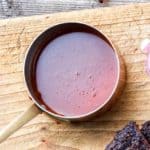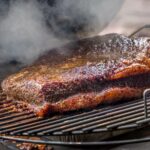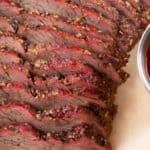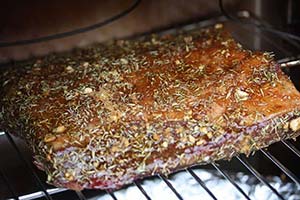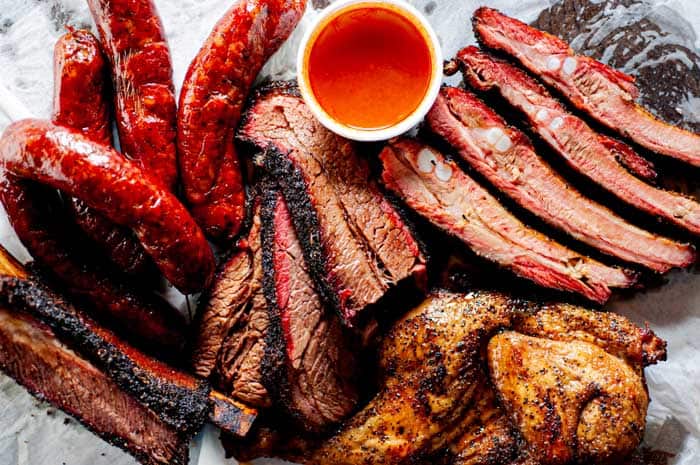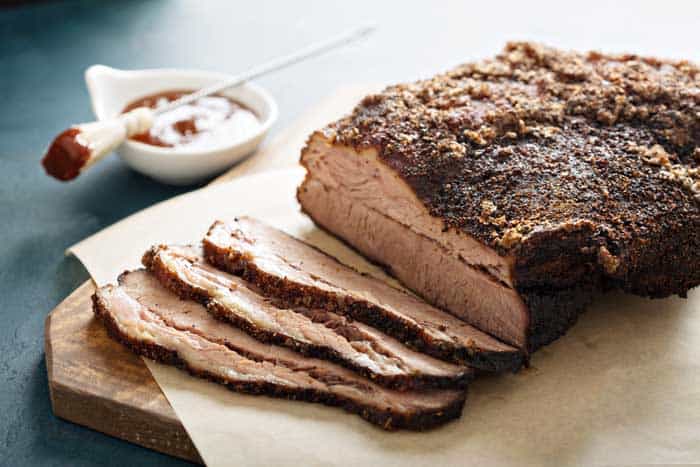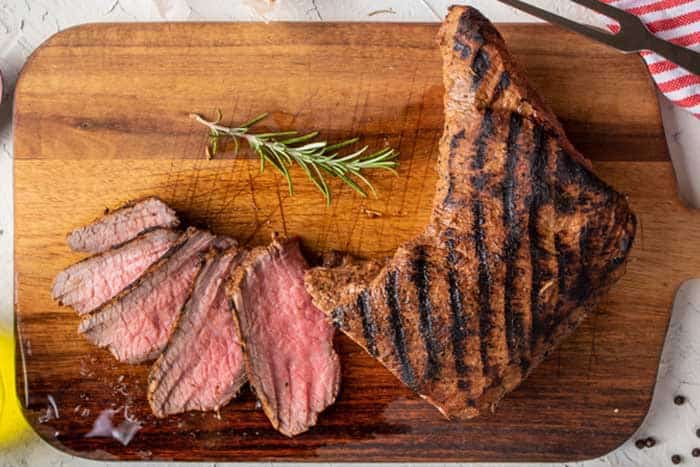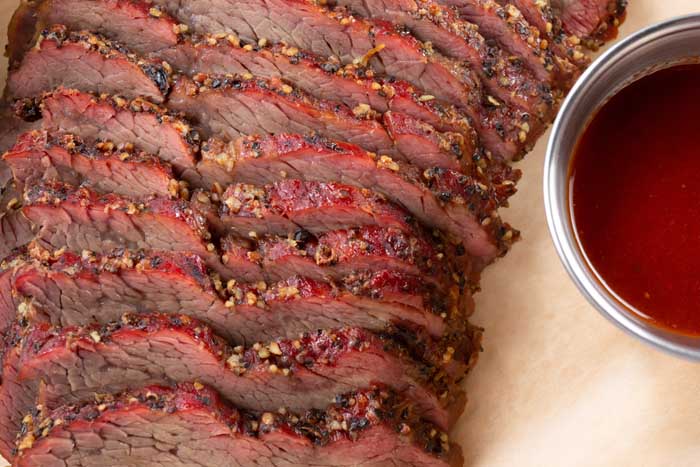Tri-tip and brisket are considered to be among the best cuts of beef for smoking. Here’s everything you need to know about the differences with our BBQ smoking guide.
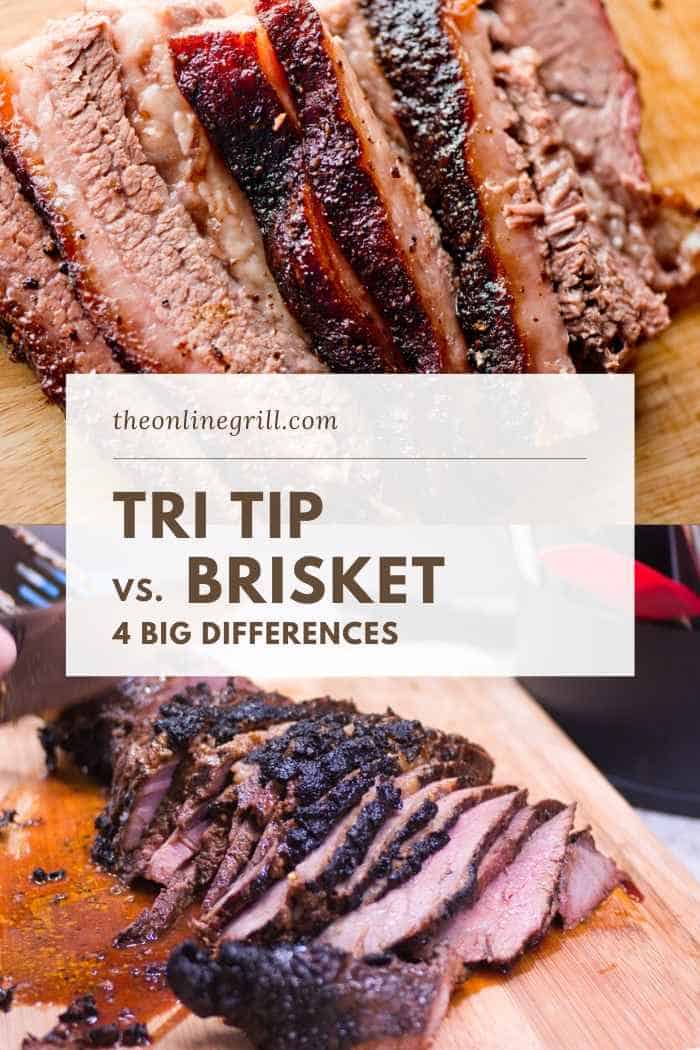
When it comes to choosing between the best cuts of beef for smoking, it’s a close call between tri-tip and brisket.
Both are universally praised because of their juicy and tender flavor profiles, but that’s where the similarities end.
This guide is going to show you the 4 big differences between tri-tip and brisket to help you decide which one you should choose for your next barbecue cook-off.
Let’s get into it!
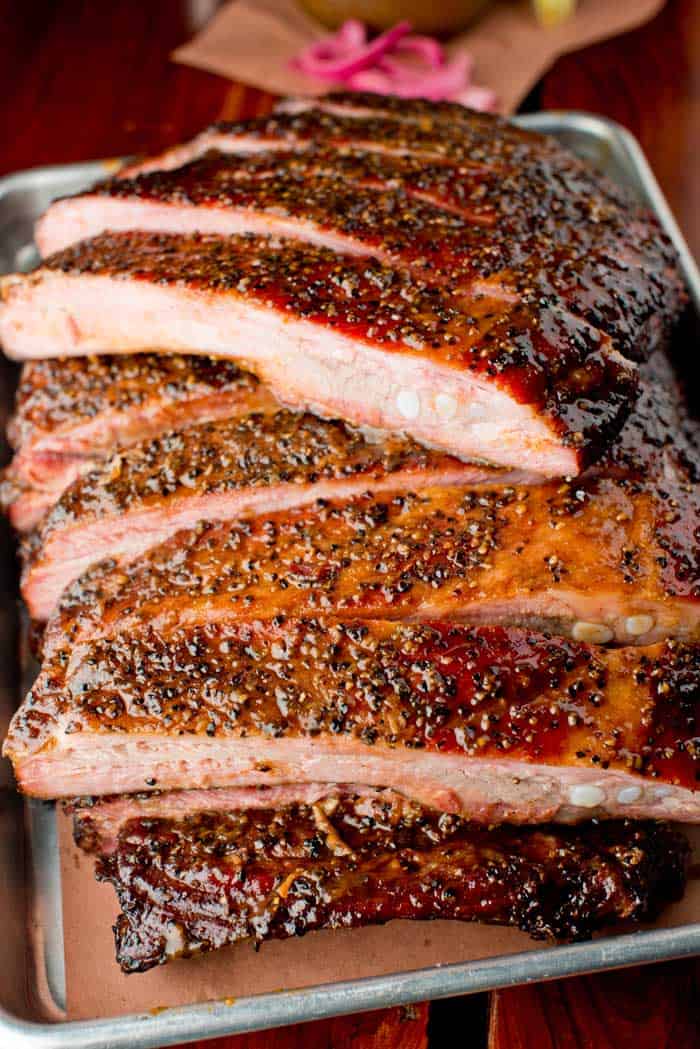
What is Brisket?
Beef brisket is comprised of large muscle sections that are removed from the chest of the cow and features a fat cap that slowly melts during the cooking process to maximize the flavor and moisture. It typically consists of two major muscles, the superficial and deep pectorals.
Because cows don’t have collar bones, the brisket does the bulk of the heavy lifting and provides support to 60% of a cow’s total body weight, hence the tough-as-nails connective tissue. See our What is Brisket? guide to learn more.
What is Tri-tip?
Tri tip is a triangular-shaped muscle with three tips. It is removed from the opposite side of the cattle, the prized sirloin region. The main muscle in the tri-tip is the tensor fasciae latae or TFL.
It is popularized because of its well known flavor and relatively lower fat content. When properly grilled, it has a pink center with a browned-to-a-crisp caramelized exterior.
Because they come from completely different areas of the cow, both tri-tips and briskets have differences in their texture, taste, size, and cooking styles. We’ve rounded up the key differences between them below.
Brisket is Bigger
A whole tri tip will typically weigh in at around 3 lbs while a packer brisket will weigh at a staggering 14 to 20 lbs. So if you’re cooking for a small family of 4 people, you’ll easily find yourself short on supply.
Brisket is a whole different story and can feed your family for several days on end, which means there will be plenty of leftovers for weeks.
Because the brisket is such a formidably large cut of meat, it is usually cut down into two sections, each serving slightly different purposes:
i) Point cut: More intense flavors with lots of fat running through the meat than a flat cut, furthermore, it is shaped a bit like a triangle, perfect for shredding.
ii) Flat cut: Less amount of fat with the fatty layer on the bottom. Because it is easier to evenly slice, the flat cut is more expensive and is typically found in rectangular and square shapes.
Tri-tip Will Cost You More
Despite being low on weight, a single pound of tri tip will cost you twice as much as brisket. It is worth noting that these price differences will vary from one place to another, but it would be fair to estimate about $10 per pound for tri tips and $5 per pound for briskets. That being said, about 30% of the brisket will be discarded during the smoking process as fat compared to you consuming almost 100% of the tri tip.
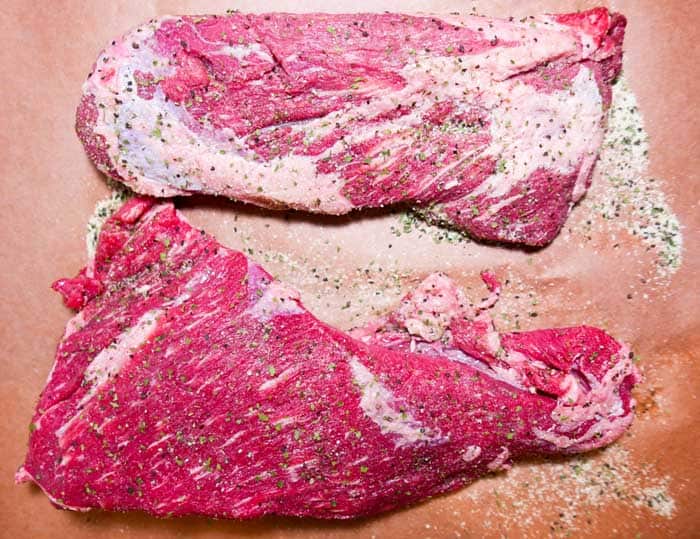
The tri-tip comes either trimmed with no outside fat left or untrimmed with a solid layer of fat on one side. While the fat helps keep the meat moist, it may melt and create problems on the grill with flare-ups.
The most affordable way to buy brisket is to purchase the packer cut leaving all of the trimming to the pitmaster. It may be worthwhile to invest in a beef processor to make precision cuts and prepare the brisket for cooking in a much shorter time.
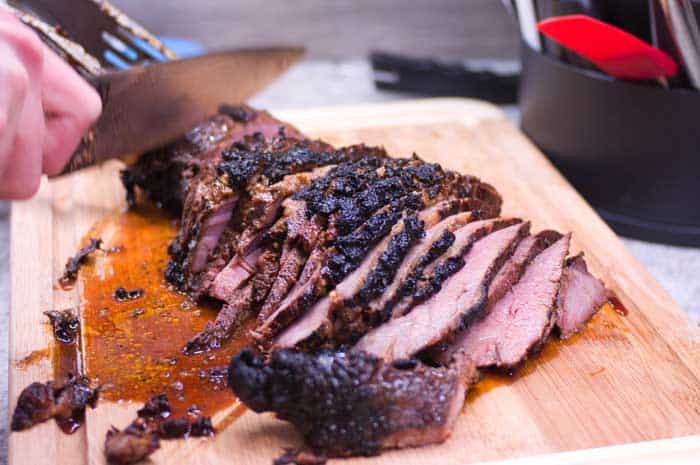
Flavor
Both meat types offer a versatile flavor profile.
Tri tips taste more like steak with beefy overtones. Despite coming from the lean part of the cattle, a tri tip has enough fat on it to make it tender while offering a buttery flavor.
Many people are quickly discovering that the tri-tip is a mouthwatering cross between a roast and steak that also happens to be mercifully forgiving when it comes to grilling time.
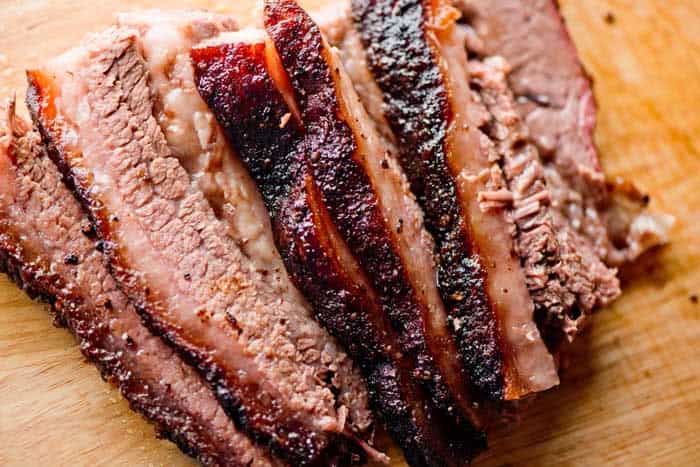
The same can be said about a properly cooked piece of brisket which has a tremendous beefy flavor. But a brisket has a lot more going for it in terms of flavor because of the presence of a crusty bark and incredibly succulent insides. When properly cooked and smoked, a brisket will look as if it’s been burnt to a cinder, but cutting on the inside will reveal a crispy bark that should melt in your mouth.
Unfortunately it’s relatively easier to botch up cooking a piece of brisket. You have to time the cooking just right otherwise the brisket will come out chewy, dry, and leathery. The brisket is a very tough meat to cook because of the abundance of connective tissue.
To counteract this, you will have to slowly cook the brisket over a long period of time giving the connective tissues to break down and gelatinize into tender meat.
Expect a lot of trial and error with multiple rounds of brisket meats before you’ll overcome that steep learning curve. But learning how to properly smoke a piece of brisket is well worth the time and effort.
Cooking Approaches
If you’ve never had tri-tip before, you’re not living life to the fullest! It’s very easy to cook and the flavor is unmatched. All you need to do is rub all the spices (use pantry spices, nothing out of the ordinary) with olive oil and then let it marinate overnight. The longer you let it marinate, the better the taste. For this reason the tri-tip makes for a very good make-ahead meal.
The detailed guide below will walk you through the process.
How to Smoke Tri-tip
Before applying the seasoning, make sure to remove any fat pieces that you want and dry them with paper towels. This is an efficient way to reduce the amount of steam buildup during grilling and helps you seal in moisture to create a juicier final product.
Pick your favorite seasoning and rub it on to the tri-tip. If this is your first time cooking tri-tips, a salt and pepper combination serves as a good introduction.
Once you have applied the seasoning, leave the meat for a few hours (or overnight) to let the flavors properly meld. While this isn’t too important, the extra time your meat spends will go a long way towards enhancing the flavor. Make sure to let the tri-tip settle to room temperature before starting your smoker and grill.
There are two ways you can smoke tri-tip. For a charcoal smoker, use a chimney charcoal starter and a few chunks of wood. For an electric smoker, toss in your wood chips and set the temperature to between 250 to 270 degrees F.
Next up is searing your tri-tip. You could sear your tri-tip on high heat first to lock the juices in or do this right after they’re smoked. The jury is still out on which method is better, our advice is to try both methods to make up your own mind.
Continue to smoke the tri-tip until its internal temperature increases to about 140 degrees. This will take about one hour or slightly more. At this point, you should sear the tri-tip on both sides for about one minute on your grill.
It is best to set aside the tri-tip for about 20 minutes. This allows the juices enough time to flow to all corners of the meat.
Slice against the grain and you’re good to serve!
How to Properly Smoke a Brisket
You can cook the brisket in a number of ways. The most popular methods include using an oven, a stovetop, a slow cooker, and of course, smoking on a grill.
Briskets are slightly more complicated than tri-tips when it comes to grilling. This is because they are comprised of two incredibly tough muscles with a mammoth amount of interconnective tissue that needs to be broken down before it could become tender.
The steps below walk you through the general process.
- Start by trimming the brisket, making sure to trim it to about ¼” fat cap.
- Next up is the seasoning or the rub. If this is your first time smoking a brisket, try using a salt and pepper combo to get acquainted with the taste. Allow the brisket to sit 30 minutes to warm up before applying the rub evenly.
- Allow a few hours for the seasoning to meld into the meat. Let the brisket reach room temperature before tossing it in the smoker. This gives the salt enough time to brine the brisket.
- For the smoker, you can choose between three types: electric, gas, and wood-fired. Whichever type you choose, it’s important to smoke the meat for about 2 hours per pound of brisket at a low, steady heat for about 220 degrees F. Make sure the fat cap side faces up during the smoking process.
- Remove the brisket out of the smoker once the internal temperature of the brisket reaches about 195 degrees F
- Set the brisket aside for about one hour to let the juices do their thing. It’s a good idea to wrap the brisket in parchment paper followed by aluminum foil to prevent the loss of heat.
- Once enough time has passed, remove the brisket from the aluminum wrap and start slicing away. Try slicing across the grain of the meat to make each cut more tender and palatable. Make sure you use a good brisket knife.
Both pieces of meat are prized for their extraordinary flavor and are among the best cuts to put on your smoker.
There are primary differences between them, most notably the place where they’re removed from. How you choose each cut ultimately depends on your preferences and the availability of the meat.

